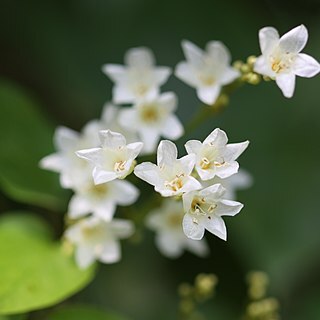A large woody twiner, up to 20 m high; stems to 1 or 2 cm thick; adult branches pale brown or grey, often minutely verrucose; young parts pilose. Leaves ovate, 3-9 by 2-6 cm, mostly broadly rounded or slightly cordate at the base, acuminate at the apex, with an obtuse, or slightly emarginate acumen; glabrous or sparsely hairy, often shining above, pinnately nerved, with 5-7 nerves on either side of the midrib; petiole much shorter than the blade, 1-3 cm, glabrous or hairy. Flowers fragrant, often in dense lateral and terminal inflorescences, forming large, broad panicles, which are leafy below. Peduncles and pedicels pilose; pedicels ca 3-5 mm. Sepals oblong to obovate, obtuse, ca 4-5 mm long, glabrous except apex and base, or sparsely pilose on the whole surface, all enlarged in fruit, oblong to spathulate, or obovate, 7-10 mm long, with 7-8 stronger longitudinal nerves. Corolla deeply 5-lobed, 8-10 mm long, white, glabrous or short-pilose; lobes obtuse, spreading. Stamens exserted, very unequal; filaments much longer than the anthers, inserted near the corolla-base. Ovary glabrous; style bifid with unequal branches; stigmas globose. Capsule broad-ovoid to globose, 3-4 mm long, mucronu-late, glabrous. Seed 1, ovoid, ca 2-2½ mm long, purple-brown or black, minutely verrucose.
More
A climbing plant or large creeper or vine. It keeps growing from year to year. The leaves are oval and dull green. They are heart shaped at the base. They are 6 cm long by 4 cm wide. The leaf stalks are 1.5 cm long. The flowers are white to yellow. They are in very large groups. The fruit is a capsule 4 mm across.
Thickets, edges of forests, teak-forests, from sea-level to ca 200 m, occasionally higher, in Timor up to 750 m. In Java mainly in parts with a pronounced dry season.
More
It is a tropical plant. It grows on the edges of forests from sea level to 200 m and sometimes to 750 m above sea level.

